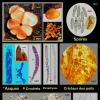
17-01-2026 19:35
Arnold BüschlenHallo, ich suche zu Cosmospora aurantiicola Lite

08-12-2025 17:37
 Lothar Krieglsteiner
Lothar Krieglsteiner
20.6.25, on branch of Abies infected and thickened

16-01-2026 00:45
Ethan CrensonHi all, On decorticated hardwood from a New York

10-01-2026 20:00
Tom SchrierHi all,We found picnidia on Protoparmeliopsis mur

13-01-2026 07:28
 Danny Newman
Danny Newman
Chlorociboria glauca on indet. decorticate logThe

15-01-2026 15:55
 Lothar Krieglsteiner
Lothar Krieglsteiner
this one is especially interesting for me because

13-01-2026 08:43
 Danny Newman
Danny Newman
Tricladium varicosporioides on indet. decorticate
Arachnopeziza aurelia !
Roland Labbé,
09-06-2009 17:21
Voici un discomycète que nous croyons être Arachnopeziza aurelia.
Tous les éléments concordent en microscopie, mais la taille des apothécies semble
grande pour cette espèce, allant jusqu'à 5 mm de diam.
Que pensez-vous de cette identification ?
Merci, amitiés ! Roland
Détails :
Date de récolte: 2009/06/03
Substrat: écorce, bois nu, feuilles et ailes de fruit d'érable
Subiculum blanchâtre
Asques cylindriques, à 8 spores bisériées, avec crochet à la base et appareil apical fortement amyloïde, 90-100 x 9-10 µm
Paraphyses cylindriques, septées, contenant des globules, 105-115 x 2-3 µm, dépassant les asques de 5-10 µm
Spores ellipsoïdes-fusoïdes, à 3 septa, formant parfois des excroissances aux deux extrémités, légèrement jaunâtres en H2O, 19-25 x 4-5 µm, 21,8 x 4,3 µm en moyenne(20 spores), Q = 5,07
Medulla formé de cellules polymorphes, ellipsoïdes, globuleuses à ± cylindriques
Poils cylindriques, septés, contenus dans une gaine de cristaux jaune-roux vif, jusqu'à 300 µm x 4-5 µm
Subiculum formé d'hyphes à paroi mince, hyalines à légèrement jaunâtres, parfois finement incrustées, 3-4 µm de diam.
Richard Korf,
09-06-2009 18:17
Re:Arachnopeziza aurelia !
Hi, Roland,
Definitely A. aurelia. One of the spores you illustrate show thew gelatinous appendages on the ascospores. These usually disappoear in dried specimens and particularly if mounted in KOH. The spore size is within normal range for this species. All the substrates you mention are typical, also.
Dick Korf
Definitely A. aurelia. One of the spores you illustrate show thew gelatinous appendages on the ascospores. These usually disappoear in dried specimens and particularly if mounted in KOH. The spore size is within normal range for this species. All the substrates you mention are typical, also.
Dick Korf
Roland Labbé,
09-06-2009 18:41
Re:Arachnopeziza aurelia !
Thank you Dick.
What do you think about the apothecial size ?
We don't see that range in littérature, instead until 1 mm diam.
Roland
What do you think about the apothecial size ?
We don't see that range in littérature, instead until 1 mm diam.
Roland
Richard Korf,
09-06-2009 19:09
Re:Arachnopeziza aurelia !
Apothecial size is very often up to 3 or even 5 mm. The 1 mm maximum sounds like you are reading the size of A, aurata, not A. aurelia!
Dick
Dick
Hans-Otto Baral,
09-06-2009 20:16
Roland Labbé,
09-06-2009 21:57
Re:Arachnopeziza aurelia !
Merci à vous Dick et Hans.
Yours answers are quite just.
Friendly ! Roland
Yours answers are quite just.
Friendly ! Roland




